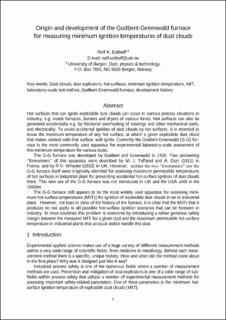Origin and development of the Godbert-Greenwald furnace for measuring minimum ignition temperatures of dust clouds
Journal article, Peer reviewed
Accepted version
Permanent lenke
https://hdl.handle.net/11250/2722754Utgivelsesdato
2019Metadata
Vis full innførselSamlinger
Originalversjon
Process Safety and Environmental Protection. 2019, 129, 17-24. 10.1016/j.psep.2019.06.012Sammendrag
Hot surfaces that can ignite explosible dust clouds can occur in various process situations in industry, e.g. inside furnaces, burners and dryers of various kinds. Hot surfaces can also be generated accidentally e.g. by frictional overheating of bearings and other mechanical parts, and electrically. To avoid accidental ignition of dust clouds by hot surfaces, it is essential to know the minimum temperature of any hot surface, at which a given explosible dust cloud that makes contact with that surface, will ignite. Currently the Godbert-Greenwald (G-G) furnace is the most commonly used apparatus for experimental laboratory-scale assessment of this minimum temperature for various dusts.
The G-G furnace was developed by Godbert and Greenwald in 1935. Two pioneering “forerunners” of this apparatus were described by M. J. Taffanel and A. Durr (1911) in France, and by R.V. Wheeler (1913) in UK. However, neither the two “forerunners” nor the G-G furnace itself were originally intended for assessing maximum permissible temperatures of hot surfaces in industrial plant for preventing accidental hot-surface ignition of dust clouds there. This new use of the G-G furnace was not introduced in UK and the USA until in the 1940ies.
The G-G furnace still appears to be the most widely used apparatus for assessing minimum hot-surface temperatures (MITs) for ignition of explosible dust clouds in air in industrial plant. However, not least in view of the history of the furnace, it is clear that the MITs that it produces do not apply to all possible hot-surface ignition scenarios that can be foreseen in industry. In most countries this problem is overcome by introducing a rather generous safety margin between the measured MIT for a given dust and the maximum permissible hot-surface temperature in industrial plants that produce and/or handle this dust.
